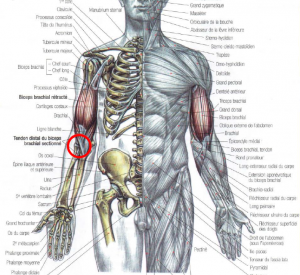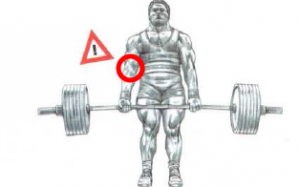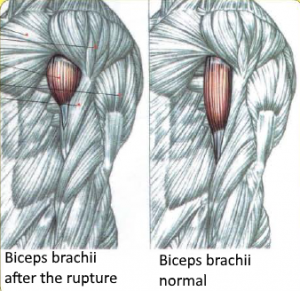I read a Frederic Delavier’s book « Strength Training Anatomy » and I learned good stuff.
Rupture or tear of the biceps long head is the serious injury the most frequent in sport
This injury usually appears on a muscle weakened by tendinitis caused by a sudden movement of the arm. Sudden arm movements are usually thrown like baseball, tennis, throwing sports and also Olympic weightlifting during the snatch. At this point, all tension transferred to the biceps long head which breaks most often where the tendon passes into the intertubercular sulcus of the humerus.
In bodybuilding, this injury is a little different, especially with the deadlift.
There is a technique in deadlift which consists of having a hand with a pronated grip and the other with a supinated grip to lift heavier weights and to avoid that the barbell rolls in the hands.
This simple technique is at the origin of the rupture or the disinsertion of the lower of the biceps (where the muscle is inserted on the humerus). Fortunately, this injury rarely happens.
During the positive phase of the deadlift, the muscles that work are legs, glutes, back and abs. Arms relaxed but they stretched as cranes cables.
Unfortunately, when a hand is with a supinated grip this shortens the biceps (the biceps is extremely powerful with a supinated grip). The result is that there is tremendous tension due to the heavy weights which cause the tearing or total rupture of the tendon of the radius. The biceps with a supinated grip works more than the biceps with a pronated grip.
In the deadlift, the injury is exclusively on the distal tendon of the muscle. The arms hang along the body, which causes the tension to be distributed at the top of the muscle between the tendons of the short head and the long head. For other exercises when the tension is at the bottom of the muscle, the tension is supported on a single tendon insertion.
The rupture of the biceps tendon causes a pain relatively moderate compared to the severity of the injury. If we compare the rupture of the biceps tendon with the major pectoralis or the adductors of the thighs, the pain is different. With a rupture of the major pectoralis tendon or adductors of the thighs, the suffering is so strong that the athlete must stop the effort.
It often happens that during a powerlifting competition, athletes who have a rupture of the biceps tendon during the deadlift, continue until the end of the movement.
When this injury occurs, there is swelling in the forearm because of hemorrhaging. But the most surprising thing is the retraction of the biceps which forms a ball at the top of the arm near to the pectoralis major and deltoid. This biceps retraction causes the brachial muscle in the lower arm to be more exposed.
It’s always possible to make a flexion of the arm with the rupture of the muscle, which less powerful than before, thanks to the brachial muscle, brachioradialis, long and short radial extensor of the carpus and the pronator teres muscle. On the other hand to make a movement with a supinated grip is a problem because the end of the movement is only carried out by a single muscle, the supinator muscle.
You have to be careful because this injury should be treated quickly by surgery to restore the brachial biceps tendon to the radius. If this surgical operation is not performed in time, the ball will have a fibrous transformation and retraction will be final. The arm’s mobility will always be possible but the loss of strength in flexion and supination is inevitable.
There is a solution to avoid this type of injury with deadlift with a bicep work to have a tendinous reinforcement. This exercise is to do a flexion only with forearms with a straight barbell. This exercise reinforces the biceps distal tendon but be careful by controlling the movement.
Share this article if you think it can help someone you know. Thank you.
-Steph


